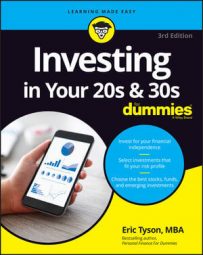As a young adult, you’re in a position to take more risks because you’re investing for the long haul. However, you should be careful that you don’t get sucked into investing a lot of your money in aggressive investments that seem to be in a hyped state. Many people don’t become aware of an investment until it receives lots of attention. By the time everyone else talks about an investment, it’s often nearing or at its peak.
Before you invest in any individual stock, no matter how great a company you think it is, you need to understand the company’s line of business, strategies, competitors, financial statements, and P/E ratio versus the competition, among many other issues. Selecting and monitoring good companies take research, time, and discipline.Also, remember that if a company taps into a product line or way of doing business that proves to be highly successful, that success invites competition. So you need to understand the barriers to entry that a leading company has erected and how difficult or easy it is for competitors to join the fray.
Be wary of analysts’ predictions about earnings and stock prices. Investment banking firm analysts, who are too optimistic (as shown in numerous independent studies), have a conflict of interest because the investment banks that they work for seek to cultivate the business (new stock and bond issues) of the companies that they purport to rate and analyze.
Simply buying today’s rising and analyst-recommended stocks often leads to future disappointment. If the company’s growth slows or the profits don’t materialize as expected, the underlying stock price can nosedive.Psychologically, it’s easier for many folks to buy stocks after those stocks have had a huge increase in price. Just as you shouldn’t attempt to drive your car looking solely through your rearview mirror, basing investments solely on past performance usually leads novice investors into overpriced investments. If many people are talking about the stunning rise in the market, and new investors pile in based on the expectation of hefty profits, tread carefully.
You don't necessarily need to sell your current stock holdings if you see an investment market getting frothy and speculative. As long as you diversify your stocks worldwide and hold other investments, such as real estate and bonds, the stocks that you hold in one market need to be only a portion of your total holdings.
Timing the markets is difficult: You can never know how high is high and when it’s time to sell, and then how low is low and when it’s time to buy. And if you sell non-retirement-account investments at a profit, you end up sacrificing a lot of the profit to federal and state taxes.

